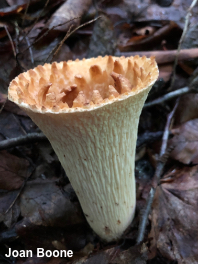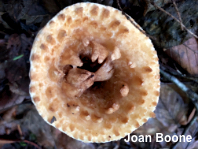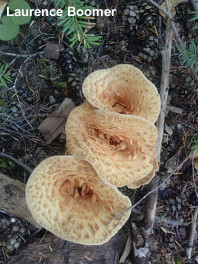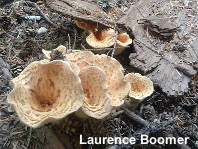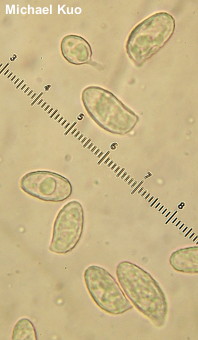| Major Groups > Chanterelles and Trumpets > Gomphoid Mushrooms > Turbinellus kauffmanii |

|
Turbinellus kauffmanii [ Basidiomycota > Gomphales > Gomphaceae > Turbinellus . . . ] by Michael Kuo Mycologist Alexander Smith named this species after his teacher and mentor, Charles Kauffman, who had collected it in Washington in the 1930s. Smith collected it himself in Washington and in Oregon, near Mt. Hood (where one of the collections described and illustrated here was made). The species has since been recorded throughout western North America, and in the Appalachian Mountains. Turbinellus kauffmanii is similar to the better-known Turbinellus floccosus. Like the latter, it is fleshy and vase shaped, its scaly cap develops a deep central depression, and its undersurface is composed of gill-like folds and wrinkles. But its colors are different; the upper surface is creamy to tan, and the scales are brown. Additionally, its scales are firm, up-turned, and diminish in size from the center toward the edge; in Turbinellus floccosus the scales are soft, appressed, and roughly the same size. Microscopically the two species are nearly indistinguishable—although, at high magnification, the spores of Turbinellus kauffmanii are more finely ornamented than those of Turbinellus floccosus. Gomphus kauffmanii is a former name. Thanks to Laurence Boomer and Joan Boone for documenting, collecting, and preserving Turbinellus kaufmanii for study; their collections are deposited in The Herbarium of Michael Kuo. Description: Ecology: Mycorrhizal with conifers; growing alone, scattered, or gregariously; summer and fall, or over winter along the West Coast; originally described from "near Mt. Baker, Washington"; distributed in western North America and in the Appalachian Mountains; reported from Mexico. The illustrated and described collections are from Tennessee and Oregon. Fruiting Body: Vase shaped and fleshy; developing a central depression that deepens with age; 7–25 cm high and 5–20 cm across (sometimes reported up to 35 cm across and 40 cm high). Upper Surface: Dry; scaly with uplifted, brown to brownish, firm scales that are large in the center but diminish in size toward the margin; dull tan to buff or orangish buff; margin wavy. Undersurface: Running deeply down the stem; covered with longitudinal wrinkles and folds; folds often forked and/or cross-veined—and, in maturity, sometimes becoming elaborately channeled and pocketed; bald; creamy when fresh; maturing to brownish; sometimes discoloring and bruising purplish brown. Stem: 5–12 cm high; 2–4 cm wide; flaring into the cap, from which it is not distinctly separate; bald; whitish; discoloring brownish; basal mycelium white; often rooting into the substrate with a basal projection. Flesh: White to whitish; very firm; unchanging when sliced. Odor and Taste: Odor fragrant, or not distinctive; taste not distinctive. Spore Print: Reported as cinnamon. I have not verified the color. Microscopic Features: Spores 11–17 x 6.5–8 µm; ellipsoid, with a snout-like apicular end; very finely verrucose; hyaline to ochraceous in KOH; Basidia 45–60 x 7.5–10 µm; subclavate; 2- and 4-sterigmate. Cystidia not found. inamyloid. Clamp connections not found. REFERENCES: (A. H. Smith, 1947) Giachini, 2011. (Corner, 1966; Petersen, 1968; Petersen, 1971; Smith, 1975; Bigelow, 1978; Smith, Smith & Weber, 1981; Thiers, 1985; States, 1990; Roody, 2003; Giachini, 2004; Trudell & Ammirati, 2009; Giachini et al., 2010; Giachini & Castellano, 2011; Desjardin, Wood & Stevens, 2015; Siegel & Schwarz, 2016.) Herb. Kuo 10231302, 07202101. This website contains no information about the edibility or toxicity of mushrooms. |
© MushroomExpert.Com |
|
Cite this page as: Kuo, M. (2021, August). Turbinellus kauffmanii. Retrieved from the MushroomExpert.Com Web site: http://www.mushroomexpert.com/turbinellus_kauffmanii.html |
